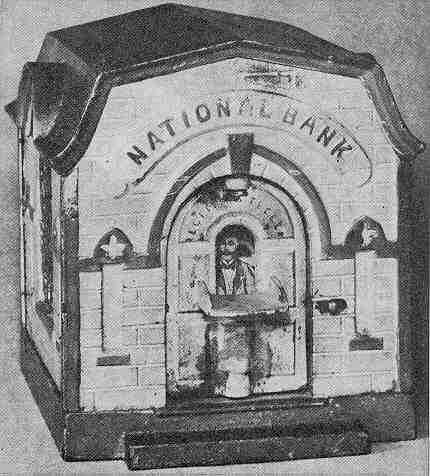National Bank
by F.H. Griffith - HOBBIES Magazine - November, 1962

Every mechanical bank has its own individual points of interest and each has its own particular appeal. Some are especially attractive, some have extra clever action, others have appealing subject matter, and so on. The individual banks then, of course, form into different groups and these groupings are of considerable interest since each has its special points of appeal.
The idea of grouping banks into certain categories such as historical, bust, buildings, shooting, and circus, and so on, is not only a basically good idea to begin with, but it also offers collectors the opportunity of getting together certain banks that have special interest to the respective collector. As an example, elephants in all forms, shapes and sizes were a favorite of the late James C. Jones, an early collector of mechanical banks. So naturally the group of mechanical banks comprising this category were of greatest interest to him, although he collected all types.
Now another factor of importance in placing mechanical banks into certain categories has to do with the spiraling prices of these desirable collector items. Frankly speaking, a considerable amount of money can be invested if one attempts to collect all the known mechanical banks—this plus the fact that many are not available at any price. So by forming the banks into groups it does enable a person to specialize in a certain field of collecting mechanical banks. The same as with coins, stamps, and other collectibles. In this fashion the investment involved is considerably less, one is actually collecting banks but just not trying to get all the different types. Please understand the writer is not recommending any particular field or group as his interest lies in all of them and he collects all the types of mechanical banks that were made. However, like all collectors, he has his special favorites and reasons for liking one bank more than another.
Actually the writer has stressed the grouping of mechanical banks largely due to the fact of so often hearing the remark as to how an average person can collect or start a collection in today’s market. Well it’s up to the discretion of each individual and certainly a good conservative method of approach is to specialize in one or more of the various groups.
A very interesting fine category of banks is the building type group. In this category are some of the more common on up to some of the rarest and most desirable banks. As we reach No. 107 in the numerical classification we have chosen the National Bank which well represents the building type of bank. The National can also be placed in another category — the cashier or actual "bank" type of bank. It is not unusual for a bank to fit into several different groups. As example, there are a number of cashier or "bank" type banks such as Hall’s Excelsior, Magic, Home, Novelty, Hall’s Lilliput, and so on. All these also belong in the building group of banks. Then the Magic Bank can be placed in a third group, the magic type itself. So a collector who may wish to specialize in the building type can acquire some very interesting specimens with good variety.
The National Bank was patented August 5, 1873 by H.W. Prouty of Boston, Mass. The patent papers are quite detailed and explicit and contain five diagrams of the bank. J. & E. Stevens Company of Cromwell, Conn., most likely manufactured the bank and in so doing they followed the pattern papers very closely, the finished product being practically identical to that described and pictured in the papers.
The specimen shown is owned by Leon Perelman who is doing a very commendable job of formulating a good collection of mechanical banks. Mr. Perelman obtained the bank a few years back from the late Henry Miller, a dealer who specialized in the field of cast iron toys. This example of the National Bank has the name in raised letters. Some others, including the writer’s example, have the name thereon in the same fashion, but the letters are not raised. The bank shown is in good original condition and painted as follows: The roof is red with yellow eaves; the front, back and sides of the building are a cream white, and the ornate filigreed windows (one each side and back) are green. Outlining of various parts is done in blue and the base is yellow. The name National Bank is in black and the wording "Receiving Teller" appears on the inside of the door. The figure of the teller is tin covered with a printed paper.
To operate the bank a small brass knob on the door is pulled forward, this causes the door to turn on a center axis. In turning the door a full half revolution it snaps into place in the position shown in the accompanying photograph. As the door revolves into position the figure of the teller (inside the bank) moves from the right to the left and centers itself to appear in the back of the opening in the door. A coin is then placed on the tray located on the door, the operator presses the small brass knob to the right, the door rapidly snaps closed throwing the coin into the bank, and the teller moves swiftly to the right inside the bank and disappears from view. The bank must be reset each time a coin is to be deposited.
The National Bank is a rather difficult item to find, particularly in good condition. It is an early item as mechanical banks go and apparently was not made in any great quantities nor over a long period of time. The writer has never seen one of these banks in what he would call fine or mint condition.
